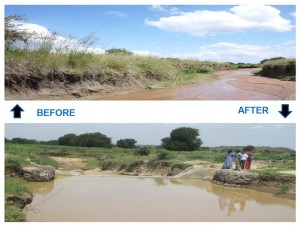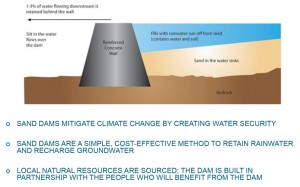
Donate
Categories
Archives
- March 2019 (1)
- January 2019 (2)
- December 2018 (2)
- November 2018 (2)
- October 2016 (1)
- May 2016 (1)
- January 2015 (1)
- September 2014 (1)
- August 2014 (1)
- July 2014 (1)
- May 2014 (2)
- April 2014 (1)
- March 2014 (1)
- January 2014 (1)
- October 2013 (1)
- September 2013 (1)
- July 2013 (3)
- June 2013 (1)
- February 2013 (1)
- December 2012 (1)
- October 2012 (1)
- July 2012 (1)
Sand Dams
Thursday, September 4th, 2014
Sand dams

A sand storage dam (or sand dam) is a small dam built on – and into – the riverbed of a seasonal river or ephemeral stream. Sand dams effectively increase the volume of groundwater available for abstraction as well as prolonging the period in which groundwater is available. Since a large quantity of the water is additionally stored in the riverbanks the volume of water available for abstraction is considerably larger than just the volume present in the riverbed sands. Water is captured through a scope hole, hand-dug well or tube well, supplying water to nearby villagers in the dry season.

Applying conditions:
– Intermittent rivers in regions with semi-arid climates and erratic but intensive rainfall,
– Sandy riverbeds experiencing high sediment loads after heavy rain storms,
– River valleys with gradients between 1% and 2%,
– The dam location should be chosen carefully to ensure the highest storage capacity and implemented at minimum cost.
Advantages:
– Clean, good quality water due to the filtering effect of sand,
– Underground storage means limited evaporation, less chance of pollution and no breeding of surface-water disease vectors,
– During a period of serious drought, some dams still provide water,
– Water is also stored in the riverbanks. Through the increased base flow from the banks, the riverbed can be recharged during the dry season,
– Low maintenance (costs) and long life.
Here is a photo of our first Sand Dam built in North Eastern Uganda. The villagers have already used this as a resource in the 2013 dry season. Many other communities are walking to this Sand Dam to access it for water in the dry season as well. They are so grateful for this life saving change for their families and communities.
Sand Dams
Thursday, September 4th, 2014
Sand dams

A sand storage dam (or sand dam) is a small dam built on – and into – the riverbed of a seasonal river or ephemeral stream. Sand dams effectively increase the volume of groundwater available for abstraction as well as prolonging the period in which groundwater is available. Since a large quantity of the water is additionally stored in the riverbanks the volume of water available for abstraction is considerably larger than just the volume present in the riverbed sands. Water is captured through a scope hole, hand-dug well or tube well, supplying water to nearby villagers in the dry season.

Applying conditions:
– Intermittent rivers in regions with semi-arid climates and erratic but intensive rainfall,
– Sandy riverbeds experiencing high sediment loads after heavy rain storms,
– River valleys with gradients between 1% and 2%,
– The dam location should be chosen carefully to ensure the highest storage capacity and implemented at minimum cost.
Advantages:
– Clean, good quality water due to the filtering effect of sand,
– Underground storage means limited evaporation, less chance of pollution and no breeding of surface-water disease vectors,
– During a period of serious drought, some dams still provide water,
– Water is also stored in the riverbanks. Through the increased base flow from the banks, the riverbed can be recharged during the dry season,
– Low maintenance (costs) and long life.
Here is a photo of our first Sand Dam built in North Eastern Uganda. The villagers have already used this as a resource in the 2013 dry season. Many other communities are walking to this Sand Dam to access it for water in the dry season as well. They are so grateful for this life saving change for their families and communities.
